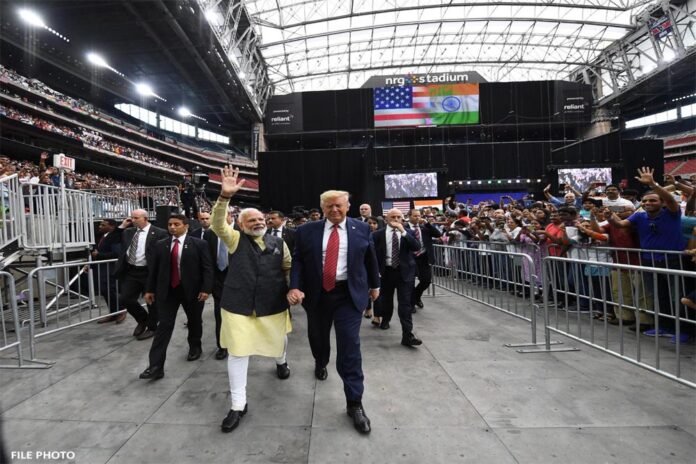On the occasion of Diwali, Trump had posted on social media site X calling Prime Minister Narendra Modi his friend. He also promised to further advance the partnership between the two countries when his government comes to power. Trump has also strongly condemned the violence against Hindus and other minorities since the coup in Bangladesh.
In America, Republican candidate Donald Trump has created history by winning the presidential election. He will be the 47th President of America. Being one of the most powerful countries in the world strategically-economically, there was a natural discussion about this election in the rest of the world. There was enthusiasm about this in India also for two reasons. First – Trump’s rival and US Vice President Kamala Devi Harris’s so-called ‘connection’ with India. It is a different matter that Harris has been more or less anti-India-Hindu. Second – Donald Trump, who has been the President before (2016-20) – openly talking about Hindu interests and taking cognizance of the religious attacks on Hindus in Bangladesh. But there is a different aspect to this truth also.
It is true that during Trump’s first term, America has comparatively interfered very little in India’s internal affairs. In 2019, the Trump administration supported the Indian surgical strike inside Pakistan in retaliation for the constitutional erosion of Article 370-35A and the Pulwama terrorist attack. This time too, Trump has expressed his commitment to further strengthen India-America relations. On the occasion of Diwali, Trump had posted on social media site X calling Prime Minister Narendra Modi his friend. He also promised to further advance the partnership between the two countries when his government comes to power. Trump has also strongly condemned the violence against Hindus and other minorities since the coup in Bangladesh. Many reports that have come out so far confirm that innumerable Hindus in Bangladesh are facing deadly attacks in the name of religion.
Will Trump’s victory in the US presidential election be the final nail in the coffin of globalization? Among the decisions taken by Trump in his first term, which included the decision to ban citizens of seven Islamic countries from entering America, his most prominent policy was ‘America First’, which Trump has reiterated this time too. In his first term, Trump had also targeted European allies along with other Asian countries including India and China through tariffs. In May 2019, Trump not only called India a ‘tariff king’, but also ended the special trade facility (American Trade Preference Program) given to India in the American market. Then Trump had said, “India is a high duty country. … When we send motorcycles to India, there is 100 percent duty on it. When India sends motorcycles to us, we do not charge them. They are charging 100 percent from us. For the exact same product, I want to charge them 25 percent.” This time Trump has talked about imposing 10 percent duty on all imports into America, and up to 60 percent duty on imports from China. In fact, this policy of Trump is inspired by protectionism, which is a threat to globalization. This development is also interesting because America and globalization have been synonymous with each other for decades.
It is true that the US has changed its strategy after adopting an ambiguous position for decades against the growing dominance of imperialist China. For the first time since 2016, the Trump administration had presented China as a ‘threat’ and ‘strategic rival’. No American President before him had seen China like this. India—which shares an approximately 3,488 km long disputed border with China—has been facing China’s aggressive policy for the past six decades, including the 1962 war and other military confrontations including Doklam-Galwan-Tawang in recent years. In this context, Trump can be expected to expand the policies of his first term, in which the Quad group (including India) was given shape by being vocal against China’s imperialist attitude.
Immigration remained a sensitive political issue in the US presidential election. Trump has been aggressive on this since his first term and his second term is expected to try to more strictly enforce his promise to stop illegal immigration. According to a report, in the last one year, under the leadership of Biden administration, America has sent back about 1100 illegal Indian immigrants. India has also made it clear that it does not support illegal migration. But if Trump shows more strictness in the matter of immigration, it can undoubtedly pose a challenge to India.
Trump and Harris made every effort to woo Indian-American voters in their election speeches (including greetings on Diwali). While Kamala was seen using the famous Indian dish ‘Idli-Sambhar’ to establish her Indian identity, Trump included his representative Vivek Ramaswamy and Usha Vance, wife of Vice-Presidential candidate JD Vance, in the election campaign. The truth is that the Trump-Harris exercise was purely political. Due to their connection with Indian culture, family beliefs and values, most Hindus and Sikhs are counted among the most affluent, prosperous and educated class of America. American-Indians constitute less than two percent of the total US population, but their average annual household income is about $1,53,000 (about Rs 1.3 crore), which is more than double the US national average. Not only this, 79 percent of Indians are graduates in America compared to the national average of 34 percent.
Terrorism is a big problem facing the world and India has been a victim of it for centuries. America’s double standards in anti-religious terrorism campaign are not hidden from anyone. ‘Good Taliban, Bad Taliban’ is a recent proof of this. Can improvement in this regard be expected from Trump’s second term?

